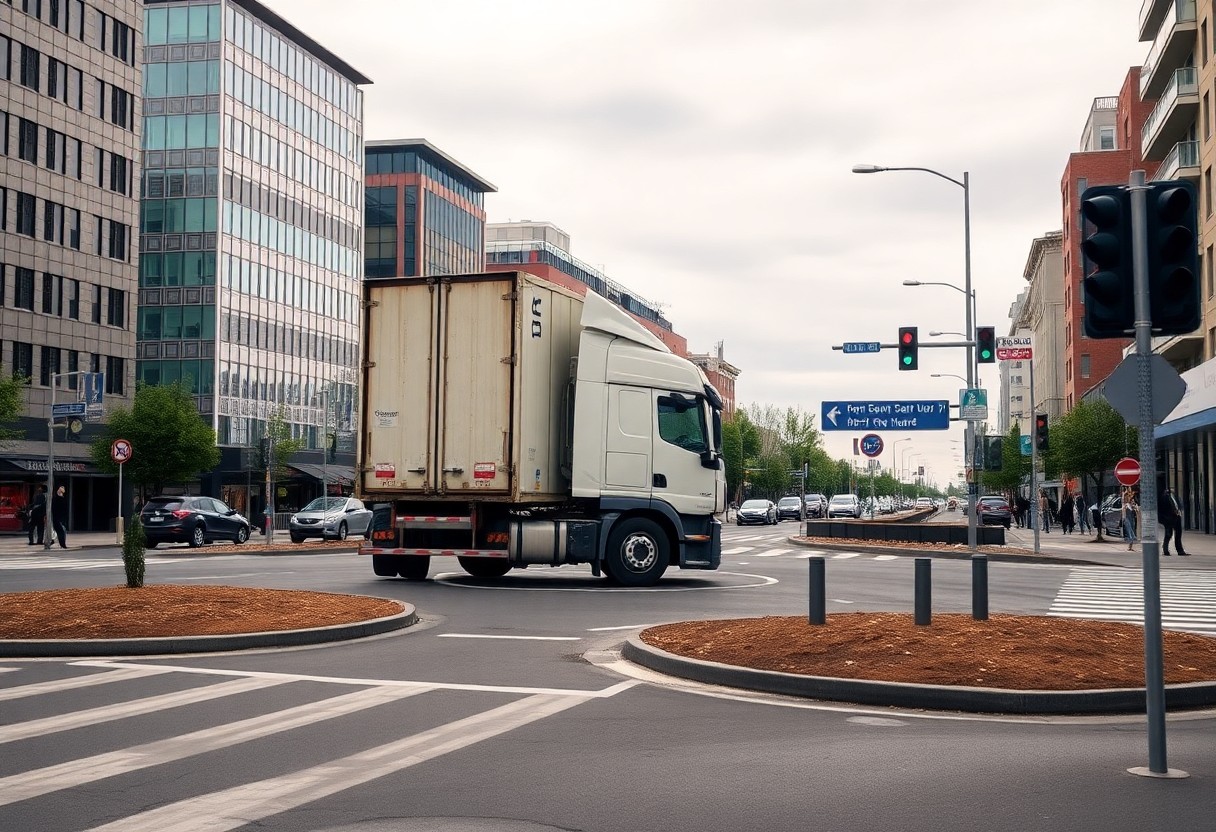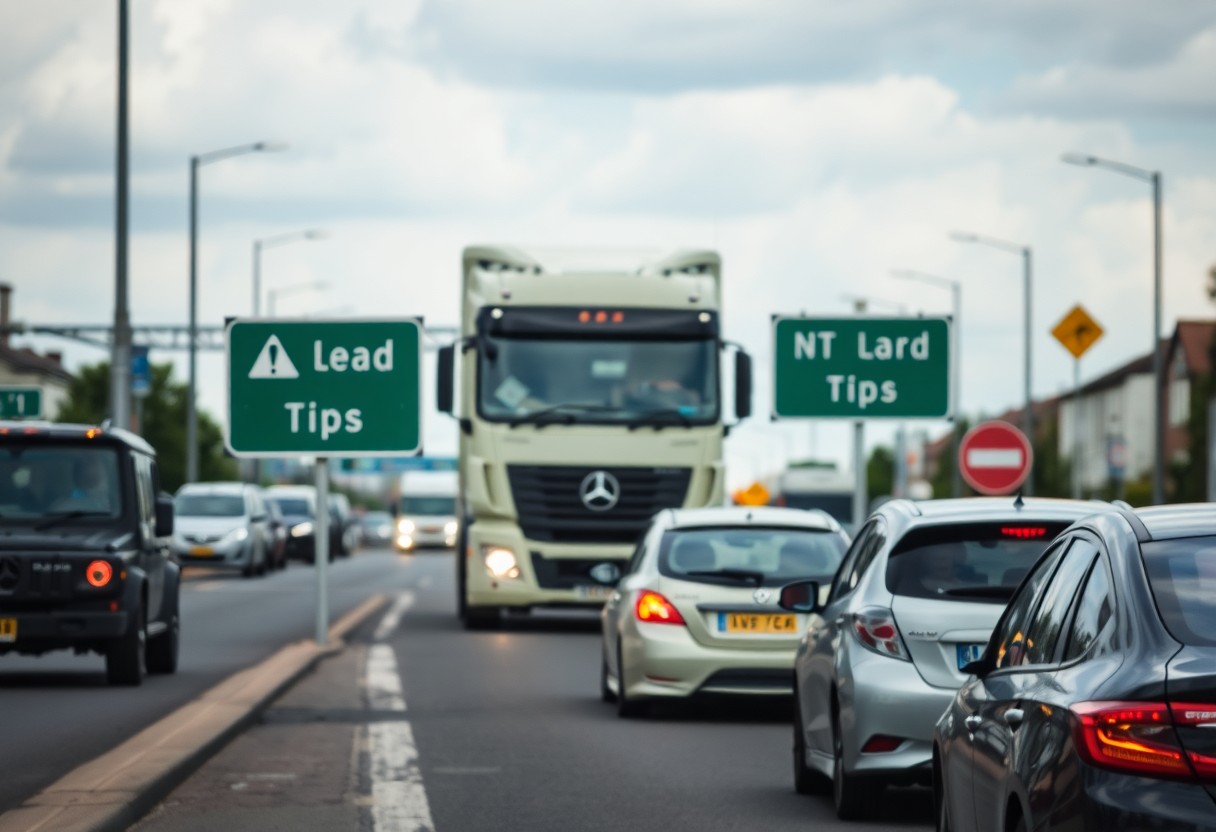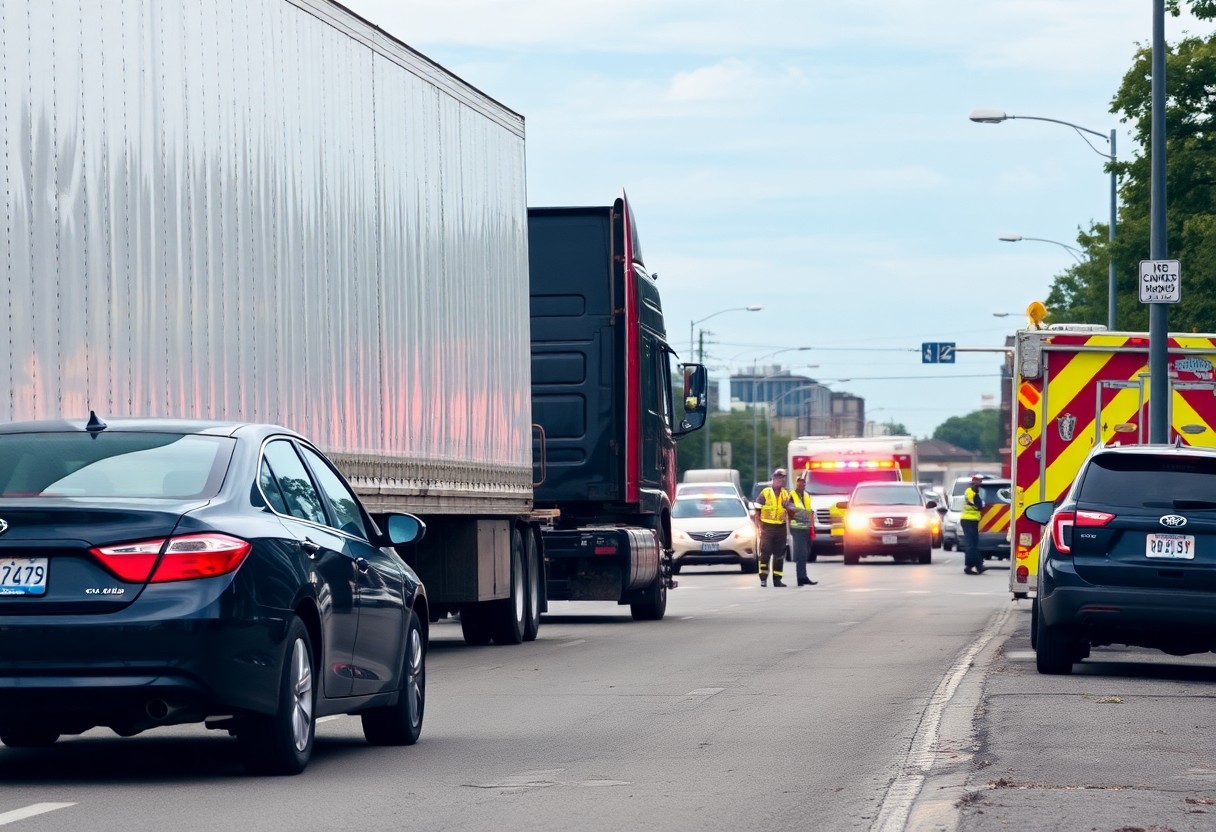Safety should always be your priority when navigating the busy streets of Jacksonville during rush hour, especially around large trucks. These vehicles have significant blind spots and require more time to stop, making it vital for you to be extra vigilant. Stay patient and maintain a safe distance; never attempt to cut off a truck. Use your turn signals well in advance and avoid sudden lane changes to ensure a smooth and secure driving experience. This guide will equip you with imperative tips to enhance your driving safety around trucks in the bustling Jacksonville rush hour.
Understanding Truck Blind Spots
A large truck’s blind spots are areas around the vehicle where visibility is significantly limited for the driver. Understanding these zones is important for safety, as a truck’s size and shape create unique challenges for smaller vehicles. Always be mindful of your positioning when near trucks, especially during Jacksonville Al rush hour when traffic is at its peak.
Importance of Awareness
Awareness of your surroundings can make all the difference in avoiding accidents. A simple glance in your mirrors or assessing the distance between your vehicle and a truck can significantly enhance your safety on the road. Staying alert ensures that you can react promptly to any situation involving large vehicles.
Identifying Blind Spots
One of the first steps in driving safely around trucks is identifying their blind spots. These zones typically include the areas directly behind the truck, alongside the right side, and, to some extent, the left side.
It is important to know that blind spots can extend up to a whole lane on either side of the truck, as well as behind the trailer. This lack of visibility makes it difficult for truck drivers to see smaller vehicles, particularly when you’re too close. When driving next to a truck, make sure to maintain a safe distance, and avoid lingering in these dangerous areas. The most common blind spot regions include the right side, where the driver can’t see you, and behind the truck, where they may not realize you’re there at all. By staying aware and avoiding these zones, you contribute to a safer driving environment for everyone.
Safe Following Distances
Even when driving near trucks during Jacksonville AL rush hour, maintaining a safe following distance is important for your safety. Trucks are larger and require more time to stop, making it vital to give yourself ample space to avoid potential collisions. Keeping your distance allows you to react properly to sudden changes in traffic or unexpected stops.
Recommended Distances for Trucks
One general guideline is to maintain a distance of at least four to six seconds behind a truck. This distance increases if you’re driving in poor weather conditions or when visibility is limited. Adhering to this recommendation will help ensure you have enough time to react if the truck suddenly slows or stops.
Adjusting for Traffic Conditions
Any time you’re driving around trucks, it’s important to adjust your following distance based on the traffic conditions. Factors such as weather, road conditions, and the density of vehicles can significantly affect how safely you can navigate around large trucks.
Safe driving around trucks means being adaptive to shifting conditions. If the traffic is heavy or the weather is inclement, you should increase your following distance to provide extra reaction time. In rainy or foggy conditions, reduce your speed and extend your distance, allowing you to stop without losing control. You should also stay vigilant for sudden stops, as heavy trucks may not be able to maneuver as easily as smaller vehicles. Prioritize your safety and the safety of others on the road by adjusting your following distance appropriately.

Navigating in Heavy Traffic
It can be daunting to navigate through heavy traffic, especially during Jacksonville’s rush hour when trucks are more prevalent. Staying alert and aware of your surroundings is key to ensuring safety. Keeping a safe distance from large vehicles and being patient while moving forward can help you avoid accidents. Always anticipate the unexpected and remain flexible in your driving approach.
Tips for Merging
If you’re merging into traffic, ensure you give yourself ample space to do so safely. Here are some tips to keep in mind:
- Use turn signals to indicate your intention
- Adjust your speed to match surrounding vehicles
- Be aware of your blind spots
- Merge in a way that maintains a smoother flow of traffic
The smoother you can navigate into a lane, the safer the merging process will be.
Changing Lanes Safely
Lanes must be changed with caution, especially around large trucks that have larger blind spots. Always check your mirrors and use your turn signal well in advance to communicate your intentions to other drivers.
Tips for changing lanes include waiting for a safe gap and ensuring that you can clearly see the large truck in your mirrors before transitioning. Make sure to avoid sudden movements, as this can surprise truck drivers who need longer distances to brake. Maintaining awareness of nearby vehicles will help you gauge the best moment to change lanes safely. The more conscious you are of the size and braking distance of trucks, the better you can navigate around them.
Signaling and Communication
Unlike driving around smaller vehicles, communicating your intentions to large trucks is important for ensuring safety on the road. Large trucks have larger blind spots, making it more challenging for drivers to see surrounding vehicles. By effectively signaling and maintaining open lines of communication with truck drivers, you can navigate rush hour traffic in Jacksonville more safely.
Using Turn Signals Effectively
Using turn signals effectively is key to ensuring truck drivers can anticipate your movements. Always signal well in advance when changing lanes or making turns, as this gives those around you ample time to react. Remember that it can take longer for trucks to adjust to your maneuvers due to their size and weight.
Making Eye Contact with Truck Drivers
Assuming that truck drivers notice your presence is a mistake; making eye contact can confirm your intentions. Since their visibility is often limited, establishing a visual connection makes it clearer you’re aware of each other on the road.
It is important to recognize that making eye contact with truck drivers not only enhances communication but also improves safety. When you gain their attention, it confirms your awareness of their position and intentions as well, creating a sense of mutual respect and trust. This is particularly important during rush hour when quick, responsive maneuvers are required. Stay alert and look for non-verbal cues from truck drivers, such as head movements or gestures, as these can indicate their awareness of your presence and willingness to cooperate.
Weather Conditions and Truck Safety
Now, understanding how weather conditions impact truck safety is vital for your driving experience. Trucks are larger and heavier than passenger vehicles, making them more susceptible to the effects of rain, fog, and other adverse weather. You must adjust your driving habits based on these conditions to ensure your safety and the safety of truck drivers around you.
Adjusting Driving Behavior in Rain or Fog
Conditions like rain or fog require you to slow down and increase your following distance. Reduced visibility can make it difficult to see large trucks and their turning movements. Use your headlights, avoid sudden lane changes, and be patient to navigate their wide turns safely.
Understanding Truck Stopping Distances
The stopping distance of a truck is significantly longer than that of a passenger vehicle. As a general rule, a fully loaded truck may take up to three times longer to stop compared to your car. This is due to their massive weight and size, which requires more time and distance to come to a complete halt. Understanding this can help you maintain a safer following distance. Should you need to stop suddenly, giving trucks ample space can prevent potential accidents.
Safety is paramount when sharing the road with trucks, particularly regarding stopping distances. A truck traveling at 60 mph can take over 300 feet to stop, which is roughly the length of a football field. You need to be aware of how close you are to a truck when approaching intersections or traffic lights. If you minimize your following distance, you risk being caught in the truck’s blind spots, leading to dangerous situations. Always provide adequate space to allow for emergency stops, thus ensuring your safety and the safety of others on the road.
Pedestrian and Bicycle Considerations
Many road users, especially pedestrians and cyclists, must be aware of their surroundings when navigating Jacksonville’s busy streets during rush hour. Trucks have larger blind spots and require a longer stopping distance, making it important for vulnerable users to remain visible and be cautious. By practicing defensive behaviors, such as staying in designated lanes and waiting for safe crossing opportunities, you can significantly enhance your safety while interacting with trucks.
Sharing the Road with Vulnerable Users
Little attention is often given to the safety of pedestrians and cyclists around large vehicles. It’s imperative to make yourself visible by wearing brightly colored clothing and using lights during low visibility conditions. Always be mindful of truck blind spots and position yourself in a way that keeps you safe. Being alert to sudden movements from trucks can prevent dangerous situations.
Tips for Safe Navigation Around Trucks
Little habits can improve your safety when navigating near trucks. Follow these imperative tips:
- Stay out of the blind spots of trucks.
- Use designated crosswalks when crossing streets.
- Keep a safe distance when riding alongside or behind a truck.
- Be patient and allow trucks to make wide turns.
Any moment you take to be aware of your surroundings significantly contributes to your safety while sharing the road with larger vehicles.
Navigation around trucks requires vigilant attention to maintain your safety. Be aware that trucks have significant blind spots, which can often lead to accidents if you inadvertently enter their paths. Always make eye contact with drivers when possible and avoid attempting to pass them in an intersection. Additionally, pay close attention to their signals and slowing patterns. These steps can enhance your overall visibility and safety, especially during busy rush hour conditions. Any small adjustment in your behavior can help avert potential collisions with trucks.
To wrap up
Now that you understand the importance of safety when driving around trucks during Jacksonville AL rush hour, you can apply these tips to ensure your safety and that of others. Always stay aware of your surroundings, maintain a safe distance, and avoid blind spots. Use turn signals early and be patient to allow trucks ample space for maneuvers. Adopting these practices will enhance your driving experience and contribute to a safer road environment for everyone.



















